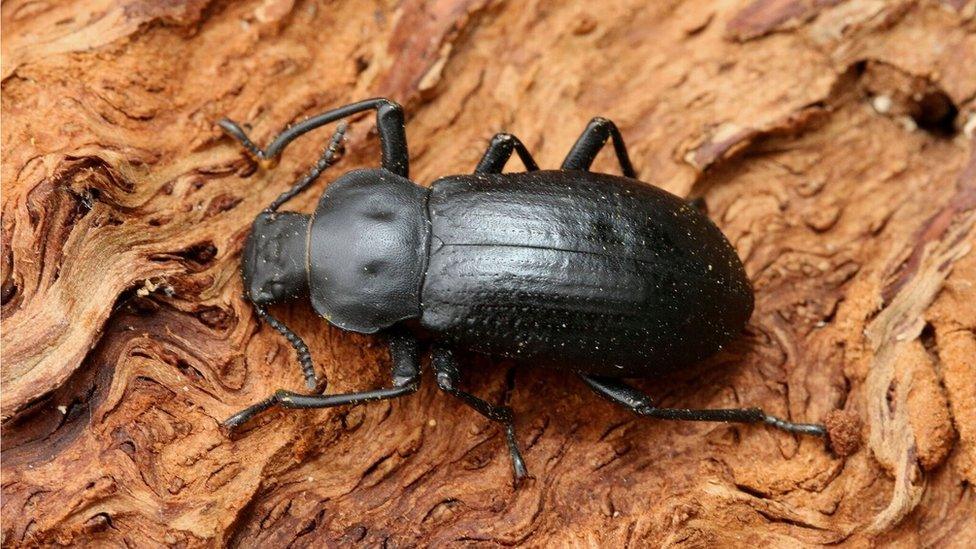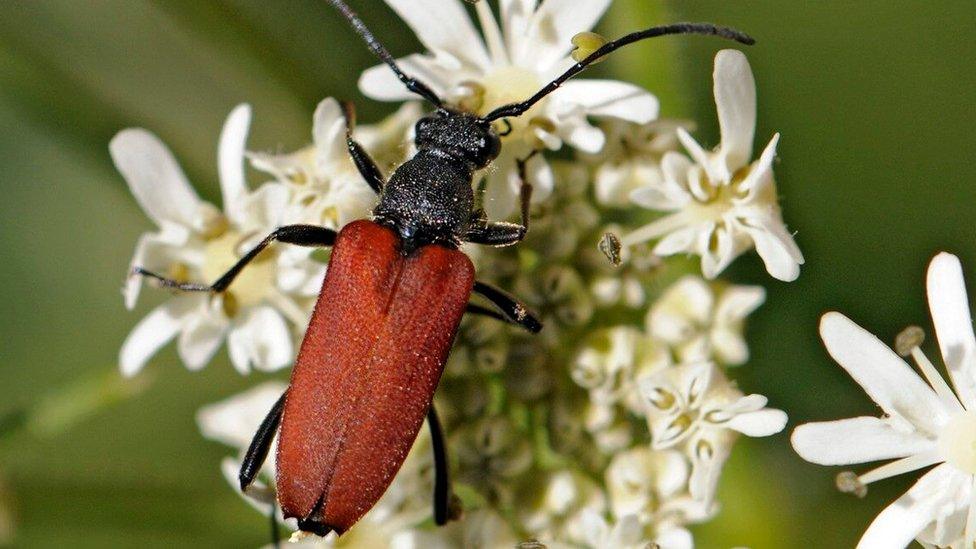Tree loss pushing beetles to the brink
- Published
- comments

This endangered beetle is found under dead branches
The loss of trees across Europe is pushing beetles to the brink of extinction, according to a new report.
The International Union for the Conservation of Nature assessed the status of 700 European beetles that live in old and hollowed wood.
Almost a fifth (18%) are at risk of extinction due to the decline of ancient trees, the European Red List of Saproxylic Beetles report found.
This puts them among the most threatened insect groups in Europe.
Saproxylic beetles play a role in natural processes, such as decomposition and the recycling of nutrients.
They also provide an important food source for birds and mammals and some are involved in pollination.
"Some beetle species require old trees that need hundreds of years to grow, so conservation efforts need to focus on long-term strategies to protect old trees across different landscapes in Europe, to ensure that the vital ecosystem services provided by these beetles continue," said Jane Smart, director of the IUCN Global Species Programme.

Beetles are food for birds and mammals
Logging, tree loss and wood harvesting all contribute to the loss of habitat for the beetles, said the IUCN. Other major threats include urbanisation and tourism development, and an increase in wildfires in the Mediterranean region.
Conservation efforts need to focus on long-term strategies to protect old trees and deadwood across forests, pastureland, orchards and urban areas, the report recommended.
It said there should be inventories of ancient and veteran trees for each European country, to ensure these trees are protected in all landscapes.
"It is critical for the Common Agricultural Policy to promote the appropriate management of wood pasture habitats containing veteran trees across Europe," said Luc Bas, director of the IUCN European Regional Office.
Monitoring
The report pointed to the need for different ages of trees in the landscape, including saplings, mature trees, ancient trees, standing dead trees, fallen tree trunks and stumps.
It said some progress had been made in the forestry sector, while the importance of deadwood is being increasingly acknowledged in many countries.
In Europe, there are 58 families of beetles, made up of nearly 29,000 species. About 4,000 are thought to rely on dead and decaying wood for at least part of their lifecycle.
However, for many of these species data is lacking, suggesting more monitoring is urgently needed.
"The population trend of half the species assessed remains unknown," said Keith Alexander, IUCN Saproxylic Beetles Specialist Advisor.
He said that three of the species from the list were found in the UK, including a type of longhorn beetle that lives only on veteran oak trees.
He called for raised public awareness of their conservation needs.
"Some of these beetles are incredibly beautiful interesting things - if people stopped and looked at them and appreciated them, they'd realise they're just as worthy of conservation as elephants and tigers," he told the BBC. "And these things live in the countryside on our doorstep."
Beetles at risk:
Stictoleptura erythroptera needs large veteran trees with cavities, and is therefore dependent on the preservation of old trees. This species was assessed as Vulnerable by the IUCN, which said its main threat was the continuing loss of old trees across its range.
Iphthiminus italicus has been assessed as endangered due to forestry practices and wildfires.
Follow Helen on Twitter, external.